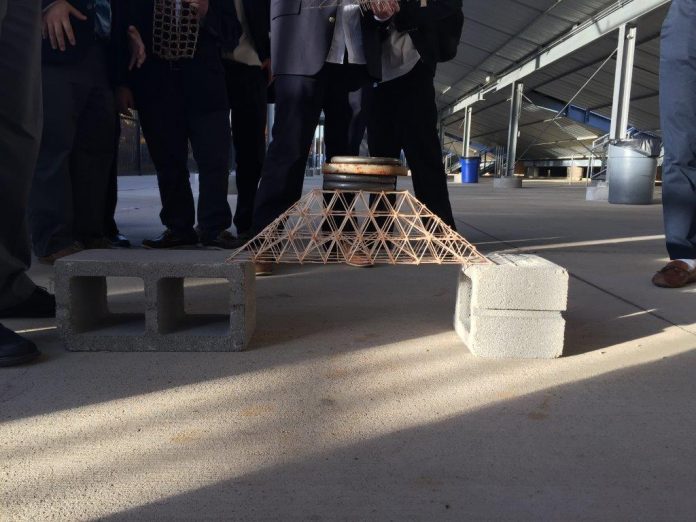When thinking of the structural integrity of a toothpick, the first thing that comes to mind is their tendency to break easily. Hence the phrase “snap like a toothpick” means to effortlessly break something, such as when a frustrated slugger breaks a baseball bat over his knee. It seems unlikely, therefore, that a bridge built solely of toothpicks could support the weight, much less a load heavier than the average fourth grader.
Constructing toothpick bridges were the regular Physics students’ extra credit project this December. The project took the shape of a competition, as groups of up to four juniors worked together to construct viable bridges out of standard wooden use-them-at-a-restaurant-to-dislodge-that-annoying-piece-of-ribs toothpicks.
To ensure fairness in the competition, the groups had to follow certain size and material guidelines in order to be eligible for testing:
-Only standard cocktail/grocery store toothpicks could be used. Other types, such as square “sandwich” toothpicks, bamboo toothpicks, or shortened wooden dowels or skewers were prohibited. Even though these are all similar in shape and size, the structure of the toothpicks and even slight variations in thickness or shape can dramatically influence the strength of the bridge.
-The only adhesive allowed was glue, although the students could choose between Elmer’s, wood glue, etc. They were also not allowed to use glue beyond the joints in excess, such as coating entire toothpicks to form bunches. The bridges were meant to be made primarily of toothpicks, so adhesives such as rubber cement, which could structurally strengthen the bridge, were prohibited.
-Although the design was left open to the students, the bridges could not be painted.
-The toothpicks could not overlap farther than .5 cm. This, again, was to prevent toothpicks from being bunched together in order to essentially form a log of toothpicks instead of a bridge.
-The bridges had to be between 55-60 cm long, 15-20 cm wide, at least, 1 cm tall, and could not extend below the base of the bridge. To control more variables in the testing (such as different distribution of the weight), the bridges were restricted in size.
However, beyond these stipulations, the number of toothpicks used and the design of the bridge were left entirely up to the students. The students used their knowledge of dynamics from the first semester of the class, to design the sturdiest bridge possible. Dynamics encompasses forces, including the force that gravity exerts on a given mass or weight. Just as a bridge in the real world needs to support the weight of vehicles and/or pedestrians, the toothpick bridges had to withstand the same force of gravity, acting on weights in place of cars.
“I thought it was interesting to see how what we learned in physics over the first semester could translate to architecture and other real-world applications,” said Heath VanKirk ’17. “We were able to take these theoretical concepts and apply them to a real-world situation, which was really cool.”
At their respective testing times, the bridges were placed across two cinder blocks, spanning the gap between them, to simulate the forces sustained by a real bridge. As the stack of weights rose higher, the stress on the bridge increased, causing it first to bend, and ultimately break.
The most successful bridge belonged to Jackson Glenn ’17, whose bridge held 90 pounds. When asked about how long it took to build, Glenn said he “finished it in about 16 hours over the weekend” and was made “only us[ing] regular Elmer’s glue” along with toothpicks. The key, he said, was in the design of the structure.
The optimal design proved to be a structure composed of triangles in the form of a truss bridge. Triangles are the simplest two-dimensional structures, and, therefore, allow for the most rigidity when materials are connected in triangles. This idea can be seen in skyscrapers and other large structures, as they utilize triangles to support their immense weight.
Glenn said his bridge was made of “45 degree [isosceles] triangles,” creating the appearance of diagonally divided rectangles. “The uniformity of the triangles was essential,” he said, to maintain consistent structural integrity so that one section of the bridge was not weaker than any other.
Regardless of the success of their bridges, the students were able to apply their new knowledge to the real-world, and develop problem-solving skills that will benefit them in the future, even if that future doesn’t involve bridge engineering.
The strongest bridges were awarded extra credit points and Glenn will be recognized at the Junior Convocation in May.






